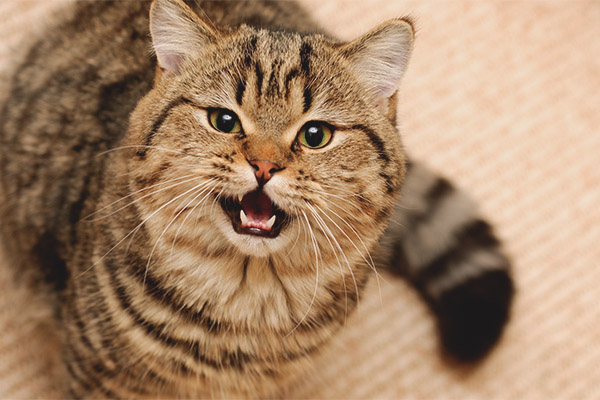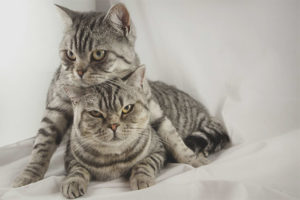The content of the article
Many cattery often face the fact that the animal suddenly becomes more aggressive than usual. Most owners tend to surround him with care and affection in the hope that the cat will start behaving as before. However, this technique does not work, and the cat puts its claws and teeth in the hands of the owner. An explanation of such aggressiveness, of course, is available.
It is also worth noting that most often aggression is manifested in white cats. This is due to the presence of Angora blood. Their relatives - Turkish Angoras are deaf animals that experience some kind of defenselessness from their condition. For this reason, they are forced to always defend themselves and show their aggression and anger. Also frequent bouts of aggression occur in blue cats.
What are the causes of aggressive cats?
Before analyzing the causes of aggression in cats, one should understand what can be considered aggressive behavior in general, and what is the nature of aggression. For cats, evil behavior is the ability to protect themselves, to demonstrate their physical strength and, if necessary, to apply it. These skills are peculiar to both street and pet animals. The presence of aggression in an animal sometimes becomes necessary, for example, when you want to protect your offspring.
It is important to bear in mind that each cat breed has its own particular behavior. This is especially true of artificially bred rocks. The fact is that such animals lack some natural instincts and traits, and therefore aggressive behavior for a number of breeds is an absolute norm. If you do not know whether to worry about the behavior of an animal that is abnormal in your opinion, you should contact breeders of the same breed or zoopsychologist.
As a rule, aggression in felines appears quite suddenly. The cat may just for no reason at all attack, start to bite and scratch. You can understand that the animal has prepared for an attack by excited behavior,dilated pupils and active tail strokes. Causes of feline aggression may be different:
- Pain. Sometimes pain can cause aggression in an animal. For this reason, if the cat behaves aggressively, it is necessary to show it to the veterinarian. Many diseases occur without clearly expressed symptoms, but cause discomfort and pain in the animal. The cause of changes in behavior can be such diseases as epilepsy, toxoplasmosis, hyperthyroidism and other diseases.
- Low-quality feed. Sometimes the atypical behavior of the pet can provoke low-quality products. In this case, you should watch the cat. If the animal starts to shudder and beware after eating, most likely the reason lies in the presence of harmful and toxic substances in the food. You can solve the problem by reviewing the pet menu.
- Disruption of hormonal balance. Often, aggression in cats and cats occurs due to changes in hormonal levels. An operation to remove the gonads can solve this problem - castration or sterilization in cats.In some cases, aggressive behavior is observed in older cats. In such a situation, the animal should be left alone. Due to his age, a pet cannot have fun and play like it used to, it should be treated with understanding, surrounding the pet with care and love.
- The struggle for territorial influence. Cats and cats always defend and protect their territory. In addition, these animals have a peculiar hierarchy, which also should not be violated. In this case, anger towards a competitor can easily spread to the owner. You should pay attention to such phenomena, especially if you want to have a second animal in the house.
- The presence of internal fear. In many cases, cats behave aggressively because they fear the people around them. This fear is present in almost every animal. The negative experience she has received in the past can often affect the behavior of a cat, quite often a bad attitude towards the animal deprives him of trust in people and other pets. The behavior of the animal and its confidence in the owner must be formed from childhood. To do this, you need to stroke the cat, caress it and take it in your arms.The kid, who as a child did not have enough care and affection, in the future may become an aggressive adult cat. It is not recommended for educational purposes to play with the kitten in your hands, and holding it in your arms. It is necessary to use special toys so that the kitten already from childhood understands that it is impossible to scratch and bite the owner.
- Lack of education. If the animal was not raised at an early age, it is likely that the cat or cat simply does not understand how to behave in the family, as well as exactly what place the pet takes among other family members. Often, cats that were not brought up by anyone, misunderstand their role and try to dominate, showing their strength.
- Redirected aggression. This behavior occurs when an animal dislikes something or someone, but cannot act directly on the subject of anger.
If you are attacked by an adult animal, you should first find out the reasons for its aggression and only then take action. If the little kitten behaves aggressively, in order to pacify his ardor, you can spray him with water. Over time, he will understand that it is impossible to behave this way and will remove his aggression towards the owners.
Effects

In order for an animal not to be constantly aggressive, attention should be paid to its upbringing. It is necessary to do this from an early age, since from the very beginning the cat must understand who is in charge at home. If the pet does not have this understanding, the following consequences can be expected:
- The animal begins to experience a real stress on the psychological background, because it believes that it is responsible for all family members, and in particular, for their safety.
- The cat does not allow itself to sleep for a long time and fall asleep too tight, because it cannot control the situation in the house like this.
- The immune system gradually begins to suffer and the metabolism slows down, since these processes in the body are restored only during deep sleep.
- The animal begins to feel unwell, which leads to stress.
- Emerging weakness causes additional experiences, because the animal worries about the safety of the family.
- The animal begins to fall into depressive states.
- Aggression becomes the only reaction of a cat that sees danger in everything.
How to avoid aggressive cats?
Education plays a big role in the behavior of the animal.Cats - pets with character, able to demonstrate their claws and teeth to any offender. That is why it is important to explain to the animal that it is not obliged to protect from everyone in the family, and is a friend who has no reason to compete with the household.
Video: aggressive cat - how to tame a furry monster?











To send